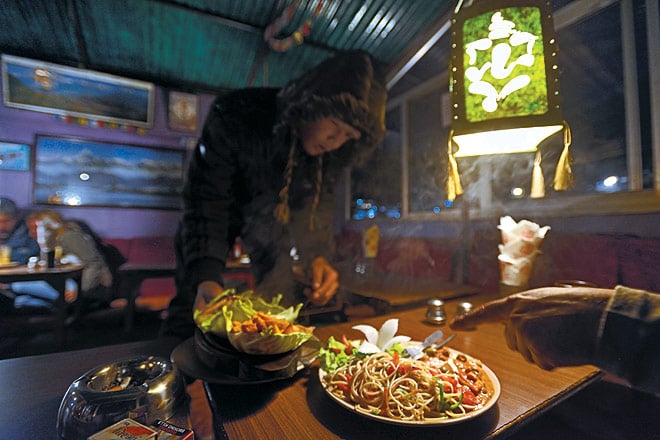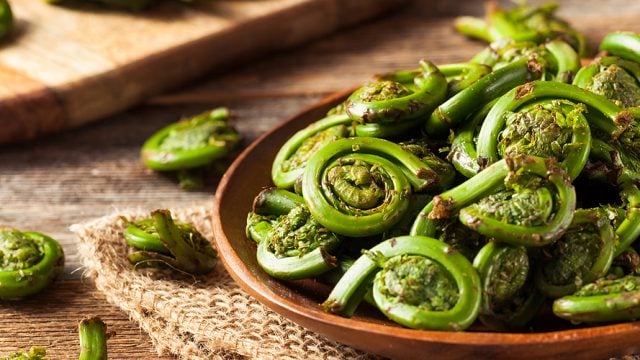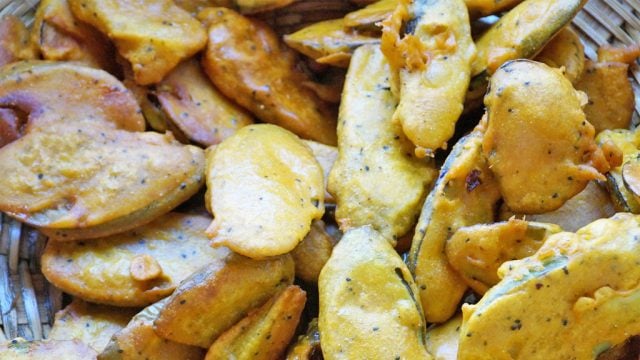Kashmiri wazwan: Jammu and Kashmir
If you have ever been a guest at a Kashmiri wedding,

Pithe parbon: West Bengal
Every year, without fail, the winter harvest takes Bengal’s legendary sweet tooth further back in time than the reign of the now ubiquitous chhena—though also accommodating the milky cheese in happier partnerships. But the seasonal stars of the corner sweet shop tend towards date syrup and rice flour, the queens of the harvest, with coconut and evaporated milk (kheer) for their handmaidens. They bring forth sweet offspring indeed, especially on Makar Sankranti aka Poush Parbon, sometimes surprisingly sophisticated and often charmingly rustic. There is the urbane patishapta, a syrup-glazed rice-flour pancake stuffed with kheer and coconut, sometimes dipped in the nolen gur fresh from the palm’s first tapping. The jaggery will continue to snub the snobbish white sugar in sandesh too, all through the chillier months. But there is also the pottery-steamed aske, the dosa-like soruchakli, the coconutty dumplings of gokul pithe, the torpedos of puli pithey boiled in sweet milk or the steamed bhapa pithey and the sweet potato informing its tender golden-fried avatar, the ranga-alu’r puli. The popped-rice ladoo called Joynogor’er moa, made of Kanachur khoi bound with nolen gur and crumbed with khoya and poppy seeds and cashews will turn up in a jhaanki (covered basket) on doorsteps and in terracotta pots in shopfronts. And home chefs, howsoever modern, will be serving nolen gur’er payesh (hot rice pudding sweetened with jaggery) to guests. Maybe with banana fritters on top.

Odiya roshogolla: Odisha
It is a shocker to snooty Bengali eyes—as if it were not bad enough that Odisha claims itself birthplace of this favourite sweet, it also does it abominably brown by caramelising the sugar to a rusty hue. It is as startling as a church wedding with a bride in red. But the taste of the pudding is indeed in the eating, and even Odisha’s jealousest neighbours cannot gainsay the roshogolla is still sweet beyond the border. But there is another story of rivalry that remains. There is the Pahala roshogolla, famous in its place, but there is a more venerable brother too—the Salepur roshogolla, called Bikali Kar after its famous maker, based near Cuttack, whose family still remain in business. Both sweets are descended, seemingly, from the khira mohana. And unlike better-known squeaky spongebobs that Bengal has seen fit to send out into the world, Odiya roshogollas retain the semolina stiffness of its crumblier ancestor. And are bigger to boot—which can surely only better? Indeed, even the reluctant Bengali calls it a rajbhog. Alas, they don’t travel as well as a K.C. Das tin, so you will have to ride out to eat it.
Amritsar street food: Punjab
Skip the midday queues and arrive early at the Golden Temple—and start with eating, at the 24-7 langar, and then do your sightseeing. Then spin away to Jalebiwala Chowk. Eat jalebis and find Sharma’s flat gulab jamuns near Kanha’s sweet shop. For lunch, let’s make it kulcha at Maqbool Road’s Amritsari Famous Kulcha. Wash down well with Ahuja’s lassi, the same since circa 1955—and ignore the lure of bright fruits, just stay with the classic. Evening snack has to be chaat and panipuri at Brijwasi, estd. 1958. Wait for sundown to go down to Beera’s for chicken that is not tandoori and fish that is decidedly not overwhelmed by frying and to Makhan’s for mutton tikka if you aren’t yet done, finishing your comfort food binge with fruit cream—maybe at Sarhad, just for the atmosphere?
Lucknow culinary safari: Uttar Pradesh
Yes, Tunday of course, with their hundred-year-old recipe, but save that galawat for last. Start instead with Mubeen’s pasanda, at Akbari Gate, for your appetiser. For your main courses, browse down Parathewali Gali, the street of flatbreads, its modest name belying the wealth of baqarkhani, sheermal, kulcha, roomali and, yes, the ulte tawe ke parathe. Then down to chowk for thandai at Pandit Raja, with bhaang free, or kesar doodh, maybe a malai paan at Raam Asrey. The evening should belong to chaat: at either Shukla or King of Chaat, eschewing the golgappe and aloo tikki for the city’s speciality of spiced peas and a tokri chaat at Royal Café if you are too stuffed. Because the morrow dawns early with Raheem’s nihari-kulcha for breakfast and Chowk again for the milk froth that is nimish, a suitably refined sweet ending. Shop for sweet souvenirs: Neelkanth’s malai ghewar and Malihabad mangoes. And then a biryani at Idrish, oh so delicate. Go sightseeing till teatime and then get Prakash ki Kulfi before you turn back for the last hurrah, Tunday-mian—get a doggy bag too, to be washed down with gulabi chai at Nakhas Market with imarti.

Indian Accent: Delhi
If we had to recommend just *one fine dining experience in India—and we are regularly asked—then let it be this. The Manor Hotel in New Delhi may be otherwise underappreciated in a star-studded cityscape, but the menu—updated twice a year—keeps it firmly on the tourist map. The restaurant specialises in seasonal ingredients in inter-cuisine, often playful, pairings that play with texture and presentation to almost singlehandedly define nouvelle Indian cuisine. Now playing for summer 2015: kadhai prawns with green mango and mixed rice puffs, mashed potatoes with black quinoa onion rings served with boondi kadhi and onion rings, stuffed morels with tandoori chicken and pink pepper malai curry (yes, all this in one dish—we did say they liked to, uh, fraternise), and a gobindobhog kheer served with sorbet and air-dried fruits! In the past we have been delighted by their duck khurchan and baingan bharta cornettos, tofu vadai with lime leaf gunpowder and tomato pickle mayo, the galawat kebab served with strawberry salsa, the tamarind fish with coconut barley and cashew pakoda, the pulled kathal phulka taco and the beetroot-peanut butter tikki. www.indianaccent.com

Dharamsala dining: Himachal Pradesh
Yes, yes, of course there is thukpa and momo. But you can find that closer to home. What you can’t find so easily is the shabaklab, a meaty crescent of pastry served with soup at Chonor House’s restaurant—it’s worth the trek uphill to McLeodganj. Shapta and sha tag can be more readily found at Common Ground Café (with lovely herbal teas) or Tibet Kitchen. Also worth tracking down is the Himachali thali, with lungur fiddleheads in season, at the Jagatram Niwas homestay further uphill. Out sightseeing on Temple, Jogiwara and Bhagsu roads, look out for a Chinese lang phing pancake. Then stop at Cafe Ri, near Green Hotel, for a spicy Korean ‘sushi’ set, kim pab, well seasoned and fish-free, and a hot bowl of bulgogi. Jogiwara Road has Japanese too, the meat-free Lung Ta restaurant featuring a weekly menu rotation. And, like the Japanese, look West for desserts—to Illiterati bookshop and café, for the marvellous Belgian waffles with the ice-cream cannonball. The coconut pie at Tibetan Children’s Village Meeting Point Café is another sweet treat to treasure, as is the ginger cake at Crepe Pancake Hut, the lemon one at Snow Lion. Best counterpoint: Italian espresso at Beans or Moonpeak, and speaking of, the Killer pizza at Blue Pizzeria. As the sun starts to set, sit down and relax at Peace Café, with all-vegetarian and innovative eats—you sip apple lassi here. For dinner, do Nick’s (excellent cannelloni and tiramisu), Jimmy’s (gnocchi) or Namgyal Café (pizza), followed by Ogo’s for (chocolate) pudding. For breakfast, the walk to Woeser’s Bakery is worthwhile, if you agree carrot cake covers all nutritional bases. There’s German bakeries and Israeli eateries, Dudu’s Falafel and Singh’s Bhagsu cake and Carpe Diem’s Hello to the Queen if you have time and appetite left, but what to take home? Aptly from the city of the Dalai Lama, self-knowledge—acquired at Lhamo’s Kitchen cookery school, making six kinds of Tibetan bread.

Northeast India foraged: North east
The bhoot jolokiya chilli and the pickled fireballs, the famous pork preserves of Nagaland are the stuff of legend the world over by now. But if you are wandering towards a closer relationship with the Seven Sisters, you need to look to the greens first. Munch some cotton rosemallow or balsam fritters, eat some chicken seasoned with wild coriander aka sawtooth, with a side of waterlily stalks in a Manipuri singju (mixed salad) and their popped seeds for a snack, moving on to Sikkim’s gorgeous gundruk ko jhol made with fermented dried Brassica greens like rayo saag (a mustard leaf), radish and cauliflower, sampling some of Manipur’s fried-fish-and-veg chamthong stew with petai beans and flowering onion shoots and mayhap some peppery prickly-ash (mukthrubi) pakodas plus a mash of pumpkin with hoary basil leaves (mayangton). Centella, creeping woodsorrel, water spinach, arrowheads, Japanese parsley, dried taro leaves and lemony Naga mejenga seeds may cross your plate as you travel deeper, approaching the very edge of the Subcontinent. And surely you won’t leave the rainiest corner of the world without savouring some fern fiddleheads?
Of course you will bring back bottled souvenirs: fermented khorisa bamboo from Assam and the fermented axone/akhuni (soybean) of the Nagas for sure, maybe some mushrooms and liver (tasu), also fermented fish and dried beef and smoked pork and chilli-flecked prawns and rustic rooster, yes, but don’t overlook the yongchak (type of Parkia beans) from Manipur or wild sesame pickles, some hog plums and perhaps the cherry-sized heibi (Meyna laxiflora), likok (a nightshade berry, cousin of the potato and brinjal) and the Khasi soh-phie (bayberries), candied olives and starfruits, and slivers of salted wild crab apple (heitup, from Manipur). When you get home, you can throw a five-course pickle party covering every food group—just add some fermented rice (pointa bhaat) and chhang beer.
Darjeeling: West Bengal
If you do one thing in Darjeeling, please eat beyond the momo and chowmein. After all, the inhabitants are not all Bengali and Tibetan, more Lepcha and Gorkha, yes? The Revolver hotel’s restaurant is a good place to find some local fare as well as Naga specialities, for a start into uncharted territory. Even more authentically Nepali is Penang’s, arguably, if you aren’t choosy about ambience. If you are lucky, your plate at either place may include gundruk (a leafy preserve of leaves leftover from cauliflower, radish, mustard family vegetables in general) or niguru (fern fiddleheads). For a simple Bengali meal, try Hotel Mahakal or Broadway. On the street, seek out aloo’r dum at Hasty Tasty. Then find salty Tibetan tea at Kalden Café or maybe some tongba beer at Hot Stimulating Café. Or if feeling ready to splurge, take afternoon tea at Windamere. And ah yes, the all-important momo and thukpa and tsampa and the thenthuk are good at Dekevas (vegetarians may prefer Kunga). And, of course, there must be tea—Nathmull’s Tea Cosy and Kho Cha are good bets for a nice long menu. For a sizzler dinner or tea and cakes with ambience, locals swear by Glenary’s. For a quicker humble repast, duck into Sonam’s Kitchen—the nettle soup, when in season, should be sought out. And if you just want casual Italian, go to Gatty’s. Or consider Danfay Munal, which will do you a picnic pack for excursions further afield on the morrow. New on the block is health-conscious Foodsteps, with even gluten-free baking. To take home, collect jars of dalle (round chilli pickle), kakro ko achaar (cucumber pickle with sesame seeds) and kinema (unsalted fermented soybean) from the bunch of shops past the stables on Zakir Hussain Road, and yak’s milk churpee cheese snacks from Keventer’s. Or just collect a bag of Kurseong, Mongpu and Kalimpong oranges!
Indian dishes
Indian food
Leave a Reply
You must be logged in to post a comment.





